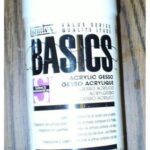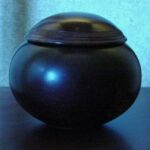You can use almost any material to create texture in your acrylic paintings, collages, and mixed media art work. Some art supplies from an art store are necessary in creating your textures. You should have a ready supply of gesso if you use nothing else, as I have tried most of these textures using only acrylic paint and gesso. Gesso combines excellently with acrylic paint and a variety of materials.
When I am creating a heavily textured piece of art, I like to start on a wood base. Canvas is too expensive for me, especially when I am just experimenting. It is also too flimsy for my heavier textures. I usually use pine, as it is sturdy, easy to work on because of it’s smoothness, and cheap in my region of the U.S. You can use any type of wood, however. I like to use whatever I can get that is cheap or free, and is smooth and in good condition. I usually don’t treat my wooden panel in any way, as the acrylic or gesso goes on untreated and unsanded wood without any problem.
Thread, String or Yarn
I like to use pieces of string, in different sizes and shapes, to create texture in my paintings. Unravel larger pieces, like yarn or thick hemp. Shred it up a little if you want, for a more natural look. Paint or pour a 1/8th inch layer of gesso onto your canvas or wood panel. While it is still wet, gently lay on different lengths of string, in a random fashion. Clumping several pieces together in places as well. Push some of the clumps and pieces of thread into the gesso, and leave some just laying on the top. This will give you peaks and valleys. Let it dry, and you can paint over it with acrylic paints.
Rice, Oatmeal, and Seeds
Using different seeds and grains , alone or together, can make interesting textures in your acrylic paintings. Put them directly into the acrylic paint, or into a layer of gesso, like you did with the string. With organic materials like food, you need to take care that they are fully covered by the paint or other medium, so they won’t start to decay and ruin your painting.
Start with a thick layer of gesso or acrylic paint. For this texture, you should use either paint, or a tinted gesso, as you will be wanting at least two colors for a two-toned effect. Crumple up pieces of plastic wrap, and stick them randomly on sections of your panel or canvas. Wait till the gesso is drying, at the tacky stage. Gently remove the pieces of plastic, and let the paint dry fully. Paint a layer of a different , contrasting color over the first, Wipe off most of the paint before it dries, leaving the second color in the peaks and valleys left by the plastic.
Sea Sponge
Sea sponges can be used two different ways to create texture in your painting or collage. The first way is simply to press the sponge gently into the acrylic to make an impression in the paint. You can also create texture with the sponge itself. First, apply a layer of paint or gesso to your panel. Cut thin layers of the sea sponge, as thin as you can make them. soak the sponge layers in either paint or gesso, and lay them on the panel, pressing in until they are embedded in the wet gesso layer. Let them dry into the paint.
You can, and should, try out new ways of creating texture for your acrylic paintings. It is a fun and rewarding experience when something works, making new and exciting and sometimes unexpected textures in your art work.




